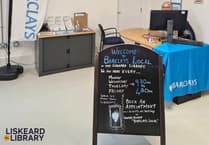TO mark ‘Blue Monday’ people across Devon and Cornwall were encouraged to take part in Buglife’s Citizen Science survey to help the rare Blue Ground Beetle.
The third Monday in January has been labelled as Blue Monday, and is said to be the most depressing day of the year, but there’s positive blue news as Buglife reopened its Citizen Science survey to help find more populations of the rare Blue Ground Beetle (Carabus intricatus) in Devon and Cornwall.
The Blue Ground Beetle is one of the UK’s rarest beetles, and is currently only known from 15 sites in Cornwall, Devon and South Wales. At up to 38mm in length, it is the UK’s largest ground beetle, and is given its name as a result of the beautifully marked and strikingly blue-coloured body. The beetles are mainly nocturnal and can be found at any time of year, although they are most active and easiest to spot from March until June.
Blue Ground Beetles usually make their homes in damp oak and beech woodland. They can be found at night, clambering up the mossy trunks of trees in search of slugs, and tend to prefer areas with not much ground vegetation and lots of decaying wood. In Devon they are largely known from Dartmoor, and in Cornwall they can be found in the east of the county in some of the woodlands surrounding Bodmin and Bodmin Moor.
In 2022 there was exciting news when Blue Ground Beetles were found at two new sites on Dartmoor. Buglife is now seeking help from the people of Devon and Cornwall to see whether there might be any more of these beautiful beetles lurking out there in the wild woodlands of the South West.
Laura Larkin, Buglife conservation officer said: “We need help to find out where these amazing beetles live. In the past, we have had records sent in of beetles found on woodland paths, and in log piles.
“Have you ever seen a large beetle that you think might be a Blue Ground Beetle? If you have, please send us a photo and help us to learn more about where these beetles can be found.”
Any records can be shared via Buglife’s South West Blue Ground Beetle project page.
Blue Ground Beetles are quite tricky to identify and can be easily confused with many other beetles, including some of their smaller, more commonly seen relatives such as the Violet Ground Beetle (Carabus violaceus) and Ridged Violet Ground Beetle (Carabus problematicus). To help with identifying any images prior to sending them in, Buglife has produced a Blue Ground Beetle Identification Guide which can be found on their website.
Laura added: “It would be absolutely fantastic if through this survey we were able to find new populations of the Blue Ground Beetle in Devon and Cornwall. There is still so much we don’t know about these beetles, including exactly where they can be found, and any assistance the local community could give us would be an enormous help”.
This survey is part of Buglife’s South West Blue Ground Beetle project which is funded by Papillon Gin and Natural England. The project itself is part of a suite of species recovery projects that Buglife is currently working on in on in the South West, all funded by Natural England. Other species to benefit from this funding include the Strandline Beetle (Eurynebria complanata), Narrow-headed Ant (Formica exsecta), Six-banded Nomad Bee (Nomada sexfasciata), Horrid Ground-weaver (Nothophantes horridus) and the Ladybird Spider (Eresus sandaliatus).
For more information about how you might be able to get involved in the conservation work for any of these species, contact Buglife.




